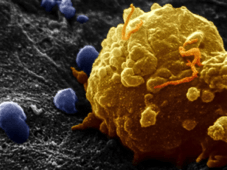Dutch researchers have synthesized an anti-metastatic drug that may be delivered in selective, tumor-targeting nanoparticles (1).
Most of the time, cancer-related deaths stem from a process known as metastasis, in which mutated cells at a certain origin spread through the vasculature to other organs. These cells avoid the immune system, which normally prevents potentially harmful agents from thriving in the body, by altering their membranous sugars. Scientists have theorized drugs that can prevent cancerous cells from changing the sugar composition of their surfaces, however these drugs have not yet been made to be selective. When administered, these drugs also affect normal cells, leading to lethal consequences (1).
Dutch researches led by Goose Adema of Netherlands’ Radboud University Medical Center are now packaging the anti-metastatic drug P-3Fax-Neu5Ac with biodegradable nanoparticles. This drug, which was first intensively studied by Cory Rillahan of the Memorial Sloan Kettering Cancer Center, targets enzymes that enable the overexpression of sugars known as sialic acids on the membrane of cancer cells. In excess, sialic acids lead to a negative charge on cell membranes, directly mediating cell-to-cell repulsion; through this process, metastatic cells can escape adhesion by immune cells and spread through the bloodstream. Although proven to impact sialic acid constitution on cancer cell membranes, P-3Fax-Neu5Ac lacks selectivity and, as mentioned earlier, can lead to dangerous complications. Specifically, James Paulson of the Scripps Research Institute discovered that mice injected with this drug experienced kidney failure (1,2).
To ensure that P-3Fax-Neu5Ac specifically targets cancer cells, Dutch researchers synthesized nano-scale polylactic-co-glycolic acid (PLGA) vesicles coated with antibodies. These antibodies are specific for surface proteins of melanoma cells known to spread to the lungs. By packaging the anti-metastatic drug with these nanoparticles, the Dutch scientists hoped that the spread of melanoma cells to the lungs could be prevented (1).
The researchers tested this method in vivo with mice as their subjects. The experimental group mice were injected with melanoma cells and the packaged anti-metastatic drug in their tail veins. Control group mice were injected with the tumor cells and empty nanoparticles. After two weeks, Adema and his team searched for the presence of tumor nodules in the lungs of the mice. They found that in experimental group mice, 75 percent fewer nodules formed in the lungs as opposed to the control group. This suggests that the drug loaded in nanoparticles slowed cancer growth while also leaving normal cells unharmed (1).
Although the study was successful in mice, it may not have the same effect in humans. The process by which humans add chains of sugars to their membranes differs considerably from the same process in mice. Hence, this drug would need to be tested in human cell lines before becoming a viable treatment option. Even though it may lack scope, the study seems to have garnered praise from the scientific community. Cory Rillahan mentioned earlier as first discovering the potential of P-3Fax-Neu5Ac remarked that: “It’s promising.” Paulson of the Scripps Institute noted that it: “opens the door” for other nanoparticle-based drug technology (1).
This study may serve as the major link between the synthesis of anti-cancer drugs and their actual practicality in patients. Also, such drugs delivered in selective nanoparticles may reduce side effects in patients, thus improving quality of life.
Sources:
1. Service, R (22 Jan 2015) Nanoparticle drug stops cancer’s spread in mice. Retrieved January 24, 2015, from http://news.sciencemag.org/biology/2015/01/nanoparticle-drug-stops-cancer-s-spread-mice
2. Fuster M, Esko J (1 Jul 2005) The Sweet and Sour of Cancer: Glycans as Novel Therapeutic Targets. Retrieved January 25, 2015, from http://www.nature.com/nrc/journal/v5/n7/full/nrc1649.html


Leave a Reply